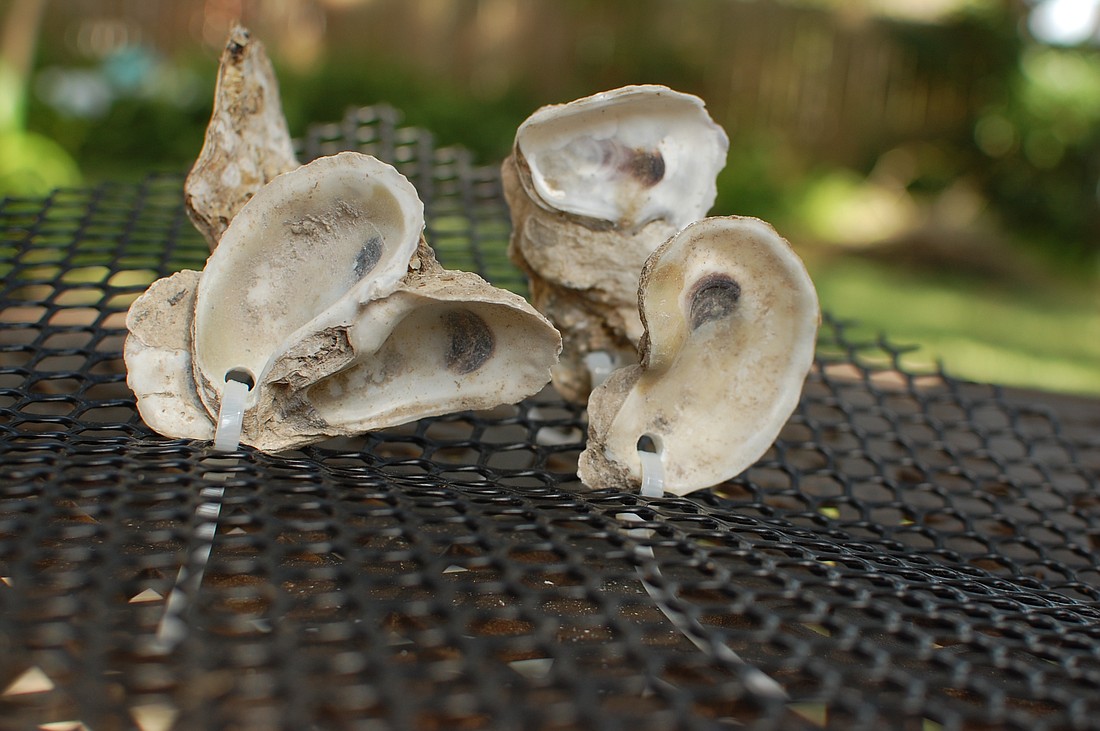- April 25, 2024
-
-
Loading

Loading

A group of volunteers headed by a University of Central Florida biologist has restored more than 40 oyster reefs in the Mosquito Lagoon over the last four years.
Dr. Linda Walters, UCF biologist and professor, said they’ve installed nearly 20,000 oyster mats — holes are drilled into oyster shells and then tied vertically to a mesh mat — in the sensitive environment that extends from Ponce de León Inlet to the north end of Merritt Island.
Once the mats are deployed into the lagoon, the oyster larvae can attach themselves to the shells, which allow the larvae to reach adulthood.
Walters and her husband, Paul Sacks, a UCF research assistant, came up with the idea for the oyster mats over a decade ago when Walters was approached by officials from the Canaveral National Seashore to figure out why oysters were disappearing in Mosquito Lagoon.
Walters said she discovered areas of dead oysters caused by boat wake disturbances. Sediment was pushing oyster shells out of the inner tidal zone and they were drying up in piles above the high-tide line.
The restoration effort
The Nature Conservancy, the organization involved in this restoration project, found in 2009 that 85 percent of oyster reefs have been lost globally.
“The majority of the [oyster] decline is due to overharvesting, although this is not the case in Mosquito Lagoon,” said Anne Birch, coastal restoration director of the Nature Conservancy Florida Chapter. “Our goal is to restore oyster reefs where we can.”
In 2007, the community restoration project officially began deploying oyster mats.
Since then, Walters said 42 reefs have been restored, and they’ve put out 19,643 mats in addition to having more than 17,000 volunteers help out with the project.
“Within the two and a half years, we have the same number of oysters-per-unit area that you have on a [oyster] reef that has never been impacted by boat wakes,” Walters said.
Oyster shells filter water in addition to creating a three-dimensional structure habitat for 149 species such as juvenile fish, shrimp and crab.
The goal of this project is to eliminate all dead areas where shells have piled up above the tide line. This project will create 47 reefs with Canaveral National Seashore. Eight to twelve reefs are completed each year, meaning this project will take another four years to finish.
Community outreach
This project is community-based, meaning it relies on volunteers to keep the project moving. The Nature Conservancy has been responsible for recruiting many volunteers to make oyster mats. So has Greg Harrison, a Winter Park real estate agent and Volunteer Coordinator for the Orlando Chapter of the Coastal Conservation Association.
Harrison was recognized last month by Field and Stream Magazine as a “hero of conservation” for his efforts in the oyster restoration project.
He hosts two-hour mat-making parties, where he teams up with local organizations for office happy hour where people get together, drink, eat and drill oyster shells.
Harrison said he received $500 from Field and Stream Magazine, and he turned the money around to help buy a new boat for deploying the oyster mats.
The Nature Conservancy has also been recruiting volunteers by going into schools to have students make the oyster mats within one class period.
What’s next?
The success of the oyster restoration project has led Walters into another community endeavor with the Canaveral National Seashore — the Turtle Mound restoration, where the goal is to put in a living shoreline.
Turtle Mound is the highest shell mound in the nation, extending upward about 35 feet.
There is a wall with concrete sandbags placed along the mound to prevent erosion, but it’s resulted in a total loss of habitat. The group plans to put in spartina, mangroves and marsh grass along the edges of the mound, which will help stabilize the shoreline.
“We aren’t stopping sea level rise, but we are putting in plants that will be an erosion break; if you put in inner tidal oysters in the seaward side, that is going to start breaking up the waves,” Walters said. “And then behind that the mangroves will stabilize sediment from the landward side.”
With the mounds so dependent upon the stability of the oyster reefs, Canaveral National Seashore resource manager John Steiner said it’s crucial to restore and strengthen them.
“The oyster reefs are very important habitat, and we want to save those,” Steiner said. “One of our mandates is to preserve and protect the resources for future generations, and so this is a way to address one of the threats to those reefs.”
Want to volunteer?
Option 1: Go to www.Joincca.org, and Greg Harrison will coordinate volunteers from there.
Option 2: go to www.nature.org/oyster for a list of mat-making events with dates. Those events are open to the public.